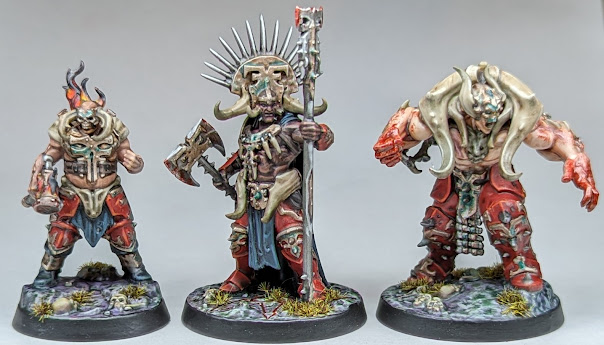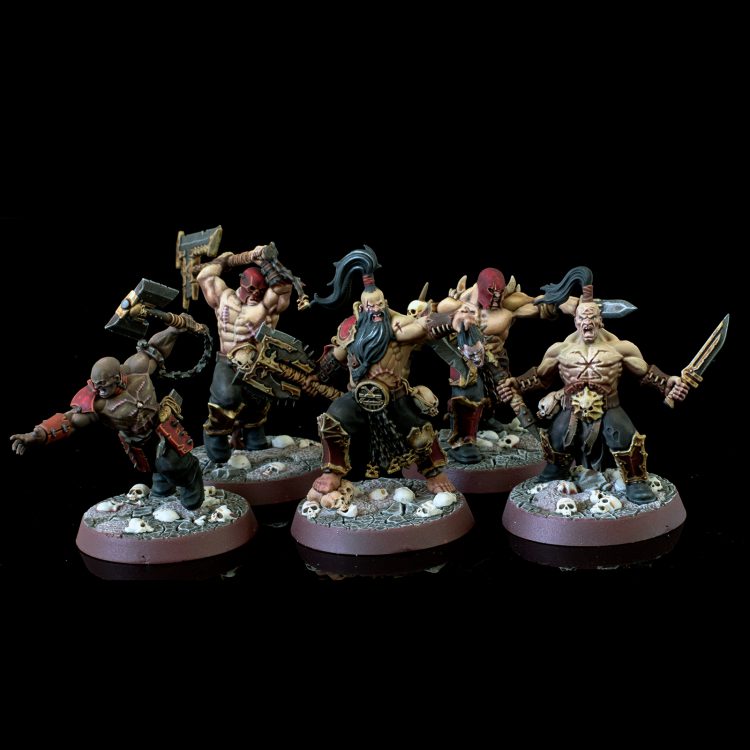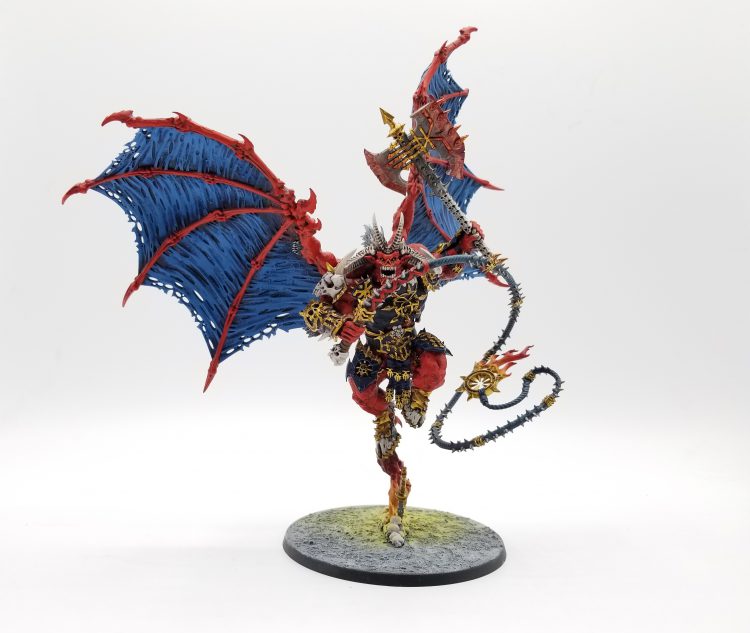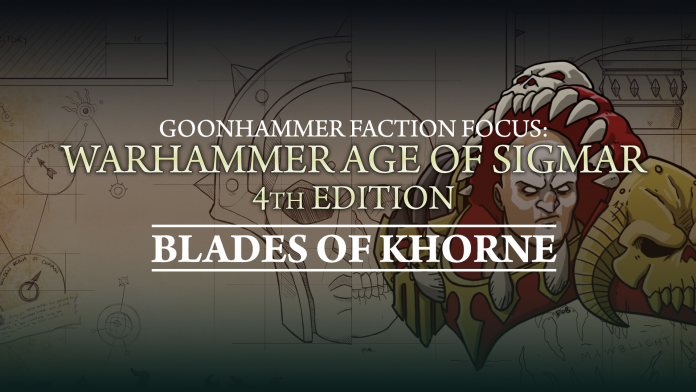Thanks to Games Workshop for sending us these rules and the Skaventide box set for review. Over the coming weeks, we will be having experts provide insight into how they are building and running lists with each faction in Age of Sigmar. For this overview, we’re looking at what stands out for each faction, how much has changed, and how we might approach some key challenges on the tabletop.
AAAAAAAAAAAAHHHHHHHHHHHHHHHHHHHHHHHHHHHHHHHHHHHHH!!!!!
…is pretty much what most of the enemies of Blades of Khorne get to hear before the slaughter begins. And during the slaughter.
Joking aside, Khorne might seem like the army that just moves at the enemy hoping to close the gap and hit really hard in melee. They mostly are, actually, but how they get there and with what number of stacked-up-buffs you can lay out will dramatically change the outcome of those fights putting them in your favour. Or in the favour of the Blood God, I guess, regardless of the outcome.

Army Rules
Same as the other faction pack overviews we’ve put up today, Warhammer Community showed off Khorne’s Battle Traits in full. These are all about collecting Blood Tithe points by killing (and losing!) full units and spending them across turns to unbind spells, make free moves, cause mortal wounds, etc
These are all relatively strong effects on their own but saving them and using them at the right time will take practice.
Battle Formations
When you create your army list you pick a Battle Formation. Each one lends itself towards a different style of play affecting specific units in your list rather than your army as a whole. Either pick one to build your army around or see which one will benefit your units the most; neither is the correct way of going about it, just a different mindset.
Khornate Legion
Once per turn after fighting with a Daemon unit a friendly Bloodbound unit can immediately fight instead of having to wait for your opponent to swing with one of their units. Daemon units are what you expect and Bloodbound are the mortal, human, side of the faction making this the “right” pick if you’re taking a mix of both. You don’t need to take an even mix of both either, just a couple daemons dotted around.
Murder Host
Non-Monster Daemons gain a 5+ Ward after they use a Fight ability for the rest of the turn. You might think “well that’s awful, I want a 5+ ward on my Bloodthirsters!” well that’s fine because they just already have a 5+ ward. Keeping your blob of Bloodletters alive however is incredibly good. It might make you think twice about which unit to fight with first though, which could cause some interesting scenarios to come up. It might seem too-good until you realise that all daemons just have a 6+ ward baked in.
Brass Stampede
When your cavalry units make an unmodified charge of 8+ they gain Strike First. That’s about a 42% chance, not incredibly unlikely but will happen less than half of the time. Gaining Strikes First is fine but typically you’ll have an army that can make better use of one of the other traits.
Bloodbound Warhorde
Like this one! All of your Bloodbound units get +1 to hit rolls against enemy units contesting objectives that are not under your control. The fastest way to take objectives from your opponent is simply by removing them from it with brute force and this helps you do just that! Objective control is determined at the end of each turn so it’s plenty easy to charge onto a point and kill what’s there.
Heroic Traits
One of your heroes in your army gets to just have one of these for free! It does not to be your General either. Just a Hero that is not Unique (so not Skarbrand).
Firebrand
If the hero was already a Priest it gets +1 to all Banishment rolls, if it was not a Priest then it gains Priest (1) instead. Getting +1 to remove enemy manifestations is nice but you’d rather simply have more prayers happening, so whack it on a non-priest. Probably the best pick of the three.
Relentless Hunter
When this hero is picked for the “Murderlust” ability it moves 6” instead of 3”. That’s suddenly much more movement and can get your Bloodthirster up the board fast OR in a safer spot combined with a Redeploy to really avoid getting charged. That’s not cowardice, it’s a tactical ploy to get your own charge off instead!
Favoured of Khorne
Very simply start the game with 1 Blood Tithe point instead of none. Gets you to the more expensive abilities quicker and means you can pull off a Murderlust turn 1 if you really need to.
Murderous Artefacts
Same as the Heroic Traits one of your non-unique heroes can have one for free, currently no way of getting more than just the one. This is also one of very few factions which has game-long artefacts instead of once-per-game effects.
Ar’gath, the King of Blades
In each Combat phase pick an enemy Hero within combat range, it cannot make ward rolls for the rest of the turn. That’s incredibly powerful. Most heroes have, or have access to, a ward of some kind so taking away a large portion of defence to take off the figurative and literal head in one fell swoop. Whack that on a Bloodthirster and go to town (and paint it red)!
Collar of Contempt
Your hero gets to Unbind one spell per hero phase and when it does inflicts D3 mortal damage to the caster too. This is the most Khorne of the bunch just going “fuck you nerd wizard” from across the table every turn. It’s not always easy to unbind but being able to deny a strong ability while doing some damage is great.
Halo of Blood
Ignore all negative modifiers to the hero’s control score, hit rolls, and wound rolls. There are a lot of negatives to hit and wound out there this edition so being able to just ignore those alone is great. Modifiers to control score are more situational but you’ll likely be happy you have that at least once.
Blessings of Khorne (Prayer Lore)
Prayers and prayer-based manifestations have been overhauled for the new edition and are just a lot more fun now than they have been before. More importantly however they’re also more interactive for opponents that don’t have priests (which is most armies). You pick a prayer or manifestation to chat, roll a D6 and if you roll well enough can either chant that prayer or manifestation or bank the roll and use that as a modifier for a later roll; if you didn’t roll well enough then you can bank that D6 value unless it’s a 1 in which case you lose D3 banked power instead.
Unholy Flames
Answer value 5 or 10+ for the enhanced effect. The target unit gains an extra point of rend until the end of the turn and +1 to wound on the higher value. A solid Unlimited Prayer but with a high value something you’ll need to start working on turn one to make greater use of turn two or later.
Witchbane Curse
I really like this one for Khorne as you pick an enemy Wizard within 18” and subtract one from its power level to a minimum of zero. Taking higher level wizards down a peg is nice but just removing a wizard’s ability to cast or banish your manifestations is incredible and you only need a 4+ to answer. On an 8+ the wizard also suffers 3 mortal damage; most foot wizards only have between four and six wounds so a couple turns of this will just remove them from the game. Combine with the Collar of Contempt and you could be removing low health wizards left and right.
Blood Boil
Another 4+ answer rolling a number of dice equal to the number of models in the enemy unit targeted. Each 5+ deals a point of mortal damage. Throw that at a unit of 40 clanrats and you’re picking up about 13 of them in one go. On an 8+ chant you also subtract 1 from the unit’s wound rolls, turning the spell from just damage to utility. There might not be a massed horde to effectively hit for mortal damage but there’s always going to be something to debuff.
Judgements of Khorne (Manifestation Lore)
All of these summon on a 4+ and manifestations don’t have a higher-value to chant, they’re either summoned or they’re not! If they have a movement value then they can’t be placed within 9” of enemy units and can’t be moved the turn you set it up but otherwise act as one of your units!
Bleeding Icon
The only one that doesn’t move so it can be set up within 9” of enemy units but enemies can also be set up within 9” of it and can still charge it, so be careful! It’s also a bit situational…slam it down near where some melee is going to happen. Whenever an enemy unit within 8” uses a command roll 2D6 and on 8+ they lose the command point but the order is not issued. Stopping bonuses to hit, save, or even things like Countercharge or Power Through can be very powerful but it’s a short range.
Hexgorger Skulls
Whenever a manifestation is two pieces you only have to kill one of them to remove the whole thing which keeps it simple. They move 8” and have to stay within 8” of each other as well. Each skull makes a couple of attacks with no rend and D3 damage but has an 8” aura debuff of -1 to all casting rolls for Wizards. Giving your opponent more stuff to just have to deal with is great and this edition largely has higher cast values and many less ways of getting positive modifiers to those rolls.
Wrath-Axe
By far the coolest looking of the three; it’s a giant flaming axe, like, come on that’s just great. It also moves 8” (seeing a theme?) and has Fly. It deals mortal damage to up-to three units it flies over and makes three pretty solid attacks in combat. You’re not removing units with it but foot-hero-hunting is a great use.

Faction Terrain
The Skull Altar is Khorne’s only terrain piece choice and you just get it. For free (points wise anyways). It’s a reasonably tough terrain piece at 10 wounds with a 4+ save. One of your infantry priests (and you can make any hero a priest, remember) can Ascend the Alter in your Hero Phase giving them +1 to chant rolls and any effects that would come from the priest instead measure from the terrain piece giving you a wider aura of effect!
Additionally every time a friendly unit within 18” is targeted by a spell you roll a dice and on a 5+ the spell’s effects are ignored and you gain a blood tithe point. That’s a large aura that will be relatively easy to keep most of your army inside of. Straight up ignoring a third of all spells targeting your units is incredible and will make your opponent consider which spells they attempt.
Warscroll Showcase
Starting things off with one of my personal favourites, the Mighty Skullcrushers. One of the army’s two cavalry options these guys have an impressive stat like with a very rare 2+ armour save and five health per model. They deal a couple mortal wounds on the charge and like most cavalry get +1 damage. With three attacks per model with rend (and potential extra rend from the unlimited prayer don’t forget!) going up to two damage is key and with five health a solid contender to use Power Through at the end of the turn. They pair well with a Lord of Khorne on Juggernaut who gives them +1 to charge rolls and re-rolls on mortal damage impacts. That said you don’t really need the Lord to get use from the Skullcrushers, while the benefits are nice simply having more Skullcrushers might work out better. I just can’t believe they kept a 2+ save it’s kind of absurd.
Next is the only war machine in the army and one of four ranged attacks available to Blades of Khorne. That’s right, the Skull Cannon is of course a cannon that fires skulls, possibly flaming ones, at a 15” range rolling four attacks with D3 damage each. Solid profile with a tick of rend and the ability to also shoot while in combat because of course it can, it’s Khorne. Which works great because if the crews four attacks (which have Crit Mortal like Bloodletters) or the melee profile of the cannon itself kill any models with a Fight ability then it immediately gets to shoot. It doesn’t have to aim at the same unit either, so if you’re in combat with a bunch of grots and some troggoths you can get an easy kill against the grots and then shoot the cannon at the troggs! If it does deal any damage with its shooting attack then the unit wounded suffers a -3 to its control score until the end of the turn. You can shoot in your own shooting phase, charge in and kill a model to shoot again spreading out that control modifier.
Quickly I just want to run through a couple of the Priests since I covered the Lore earlier on:
- Realmgore Ritualist – Desecrates an objective marker he’s in combat range of during your movement phase giving a permanent 12” buff for +1 hit to all of your units
- Slaughterpriest – Deals mortal damage to nearby friendly unit to give you a blood tithe point and can unbind spell as if he were a wizard
- Herald on Blood Throne – Brings back destroyed daemon units on a 4+ at half starting strength so long as they started with at least 3 models, meaning Bloodthirsters are off the table; you’ll have to bring them back with blood tithe
Taking two to three priests will be common and just about necessary to run a Khorne army effectively and the Slaughterpriest here is something I can see people running multiple of. You can only use his sacrifice ability once per turn per army but getting extra blood tithe early will be key; just take some chaff bloodreavers or something that heals.
Last up is the big-guy himself Skarbrand who makes up for his shorter 8” move (compared to Bloodthirsters flying 12”) with a 3D6 charge. Averaging a 10.5” charge allows you to attempt those long bomb charges and potentially spike for an insane amount of movement. Like all Bloodthirsters he has sixteen wounds with a 4+ save and 5+ ward to keep him safe from harm but after suffering ten damage he gets real mad and gains two extra attacks with Slaughter, his damage four axe. In the other hand is Carnage with only two attacks (and not extra from damage) at damage eight each and Crit (Mortal) for when you roll double 6’s to simple remove whatever used to be in front of him. The main downside of course is once he’s dead he stays dead, there’s no reviving Skarbrand.
Bloody Battle Tactics
Battle Tactics are typically a mix of killing stuff and placement around the table. Khorne is (obviously) built for the former and has a lot of tricks and movement for the latter too. Spending Blood Tithe on extra movement and then running flesh hounds around the table to score will be common practice, as well as just bringing back Bloodthirsters where they need to be.
The only downside here might be because the army so badly wants to be in combat you might struggle for battle tactics later in the game, but if you’ve simply removed the enemy army then you won’t have trouble scoring generally. Who cares about victory points if the enemy isn’t able to score, on account of being dead.

AAAAAAAHHHHHHHH!!!
Coming full circle, ending the article how I started, perfectly balanced, etc etc it’s not even a good Bit but I’ve got nothing else.
Overall though, Blades of Khorne are looking great. Players are going to have some decisions to make across the game between sacrificing cheap units to bring back bigger-better-strong Bloodthirsters. Those chaff units aren’t bad in a fight either, able to benefit from buffs of heroes for a surprising amount of rend and damage.
I am really interested to see what people come out with for armies, what mix of mortal and daemon units they take, or is it just Oops All Daemons??
Have any questions or feedback? Drop us a note in the comments below or email us at contact@goonhammer.com. Want articles like this linked in your inbox every Monday morning? Sign up for our newsletter. And don’t forget that you can support us on Patreon for backer rewards like early video content, Administratum access, an ad-free experience on our website and more.


